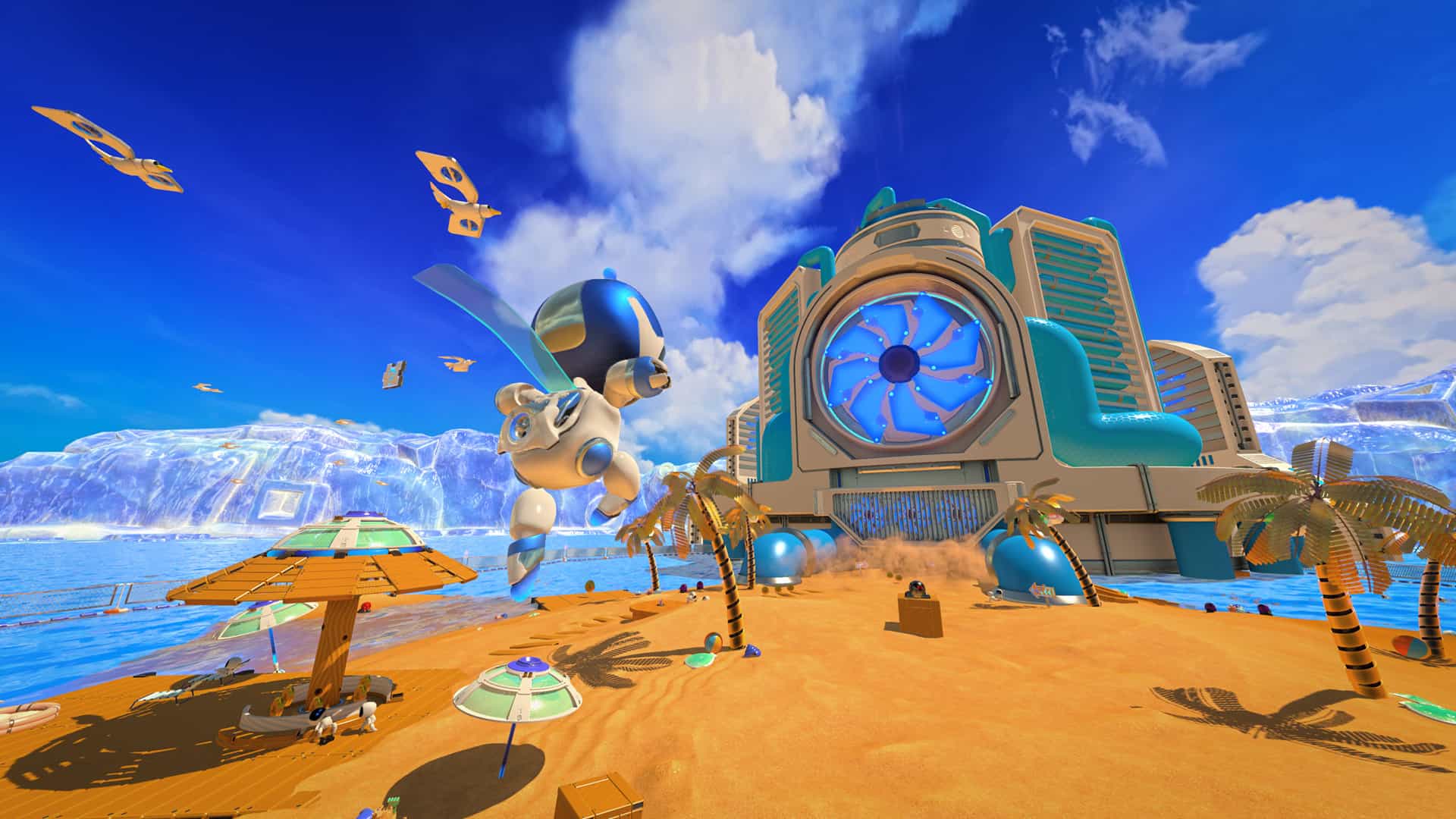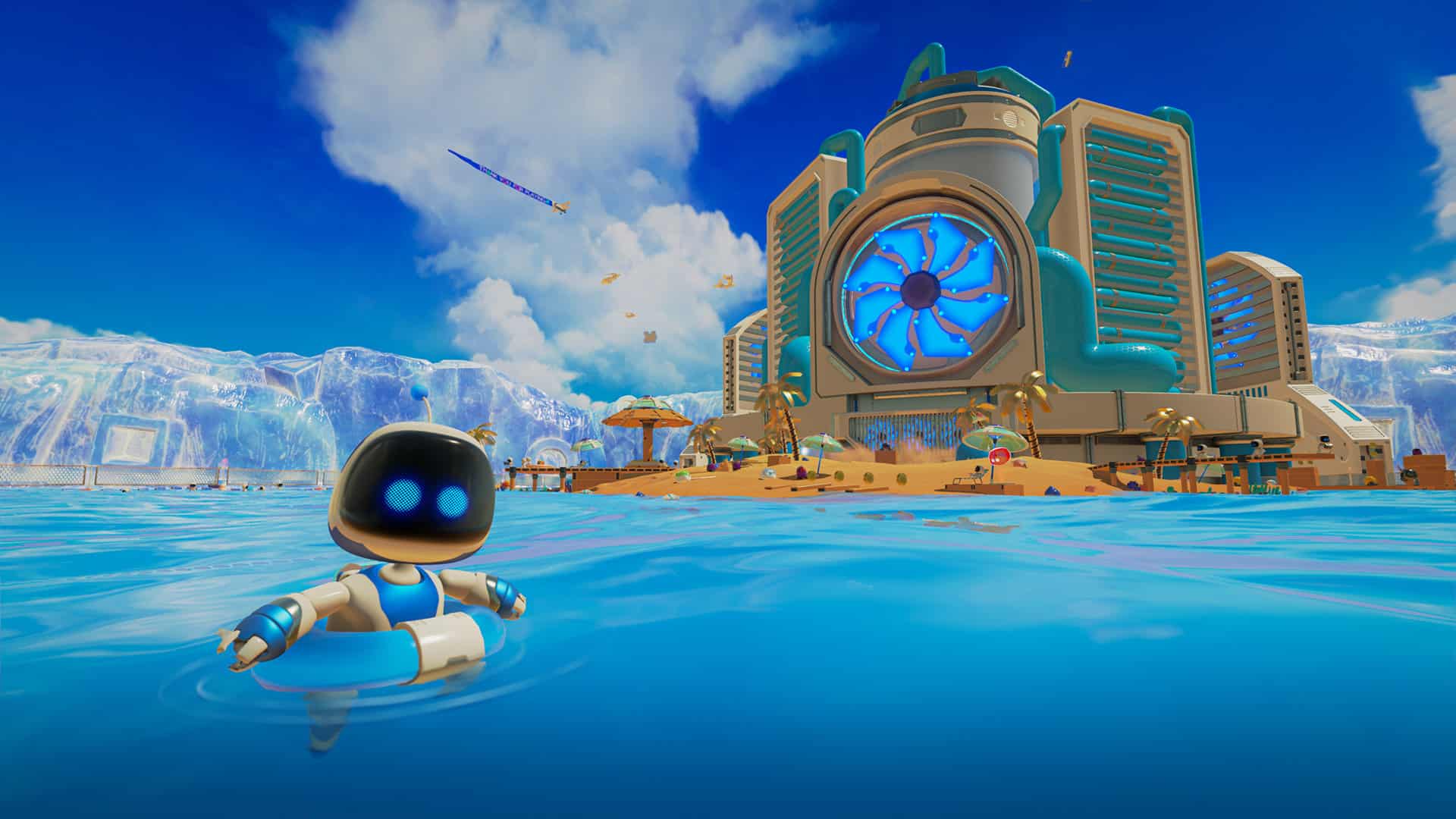You can trust VideoGamer. Our team of gaming experts spend hours testing and reviewing the latest games, to ensure you're reading the most comprehensive guide possible. Rest assured, all imagery and advice is unique and original. Check out how we test and review games here
The star of Astro’s Playroom is Astro, a small white robot. His body is bulbous, and sealed with a slippery gloss. There is a blue cape fastened to his back, matching his eyes, his boots, and the bobble on the end of his antenna. His wrists are ringed with silver, and his thoughts, however they may turn, are encased in a television head. To meet his gaze is to stare at a screen of rich black, into the blinking glow of diodes. Whatever pains are cached in his CPU, whatever the hard drives of his nature, happiness purls within his circuits. In short, our hero is hardware.
The game, meanwhile, is something else. It cannot truly be called software, for two reasons. First, it warms the corridors of the PlayStation 5, pre-installed on every console as if it were a whirring chunk of happy memory. To delete it would be like tearing a child from the arms of its motherboard. And second, it is so obsessively about hardware: both a showcase for the curious powers of the DualSense controller and an ode to the plastic that clutters the past of any who have played for long. The developer, SIE Japan Studio (specifically, the Team Asobi division), has forged a platformer from the same blend of delirium and precision that blows through Super Mario, and then filled it with fossils, looking inwards and backwards in an act of reflection that flirts with indulgence.
At the beginning, Astro is set loose inside the plains and prairies of a PS5, and finds them strewn with artifacts as dusted by the passing years as a PocketStation, a PSone LCD Monitor, and a Multitap. Each discovery is vouchsafed with a small caption, like the curling paper inside a fortune cookie. When you find, for instance, the PlayStation Mouse, you are greeted with, “You’ll have a ball with this.” The first Memory Card: “So long, overnight pauses!” And the PlayStation Portable: “Loves being held.” On the surface, the notion of a platformer having collectibles and easter eggs is no big deal, and for a company to pore over the catalogue of its own history is pure narcissism. How, then, to account for the sharp tender shock of emotion that leaps at the sight of a UMD—that little roundel, clasped in a white cassette, that bore the games of the PSP? Beyond the merely fetishistic, our love of retro tech is tied, in some faint way, to the time that we once poured into it—to the way these grey and cream shells echo not just with Sony’s bygone days but with our own. We love being held.
And so from plastic to rock; to water and glass; to grass, snow, and steel. Such are the surfaces of the adventure, as Astro makes his way through the imagined chambers of Sony’s new machine—through the likes of Memory Meadow, GPU Jungle, and SSD Speedway. And such are the textures channelled through a combination of haptic feedback; the adaptive triggers, which tense and slacken like muscles; and the speaker, which has roughly the same relationship to the rumbles of the controller as smell does to taste. Note, for example, the noises that shift as rain hardens into hail, the gentle fizz and patter frozen into a shower of pins, and helped along by the haptics.
If I were to summon a single word to describe Astro’s Playroom, it would be: ease—not of difficulty but of mood. Astro slots himself into an armoury of gizmos, including a jumping frog suit, whose steel spring seems to tighten inside the trigger, and a jetpack, which blasts through your hands as if the DualSense were flooded with rocket fuel. Add to that the minigun and the bow and arrow (firing balls and rubber bolts, naturally; not a drop of blood dares soil this electric dream), and you may gear yourself up for complication. But it never arrives. Instead, the breeziness of tone, coupled with the tricks of the controller, make the action navigable—emotionally and physically—through feel. Its fragments cohere thanks to the sensations yielded by the black-and-white lump of wire and metal clutched in your hands. How better to explore the way that technology is tangled and fused with feeling?
The platforming is accompanied by all the usual trappings—the electrified floors, the drifting blocks of cloud that vanish underfoot—but avoids the pitfall of needless complexity, which ensnares many developers who strain for freshness. The harshest criticism I can muster of Team Asobi’s game is that the undergirding of its design is nothing new. Some of the sights on offer have been cheekily cribbed from Nintendo. One enemy is a straight lift of the Whomp, those grimacing tombstones who in Mario Kart would thud into your path; however, here it has been repurposed as, what else, a CRT TV—a thudding tombstone of a different sort, whom we receive with no grimace, only a faraway smile.
There are plenty of those to go around. If you have lugged a PS5 onto your coffee table, and started Astro’s Playroom (while something else downloads in the background) with the intention of a quick taste, don’t be surprised if your entire evening blurs by. After playing through myself, I watched a friend fly through it in one sitting. This is partly down to the pleasant bubble of the art direction, by Sebastian Brueckner, which envelops you in a vision of sheer plasticity. Check out the trees, whose trunks are in fact lengths of cable, bound up with twist ties; or the flowers, whose buds have bloomed into the shapes of the PlayStation face buttons. Stay alert, as well, for Astro’s fellow-caperers, who pay homage to the characters who have, in ways great and small, described the odd shape of Sony’s success.
I can’t say my heart didn’t melt at the sight of a miniature Galahad, from The Order: 1886, toting a crackling lightning gun, with a moustache marooned on its visor. Elsewhere, in the depths of a cave, I found a robotic Joel and Ellie, hiding from a red-eyed stalker, with cute plugs of colour on its head, in a nod to the spore-infested clickers of The Last of Us. Likewise, I was moved by the music, by Kenneth C. M. Young, which includes the sorrowful prospect of being sung to by a devoted GPU (“You’ve never wondered why, / I catch your eye? / It’s ’cos you overlook, / All the choices I took”). Lurking beneath all of this, of course, is a layer of arrogance. And, whatever your opinion of Sony, it has produced its most distinctive work when borne aloft by a high opinion of itself.
Consider the PlayStation 4 (“Promised greatness. Delivered more,” we’re informed), a dark, sensible sliver, which appears to have been wrought for the pragmatic purpose of destroying the close competition. Now compare the PS3 (“With great power…”), with its bursting midriff, its oil-and-chrome finish, and the strings that surge as it powers up; it could only have been built by a company at the light-headed height of its powers, where the air grows thin, and the competition doesn’t warrant a thought. It’s this approach that has produced the billowing curves of the new console (“Number five is alive!”). At the end of Astro’s Playroom, it’s worth taking the time to survey the PlayStation Labo: the gleaming hub into which is herded the treasures of your efforts—the consoles, the peripherals, the discs—along with a trove of your own private recollections. Evidently, that is what Sony has done, too, taking stock of the chapters behind, and looking to what lies ahead.
Developer: SIE Japan Studio (Team Asobi)
Publisher: Sony
Available on: PlayStation 5
Release Date: November 19, 2020
To check what a review score means from us, click here.







